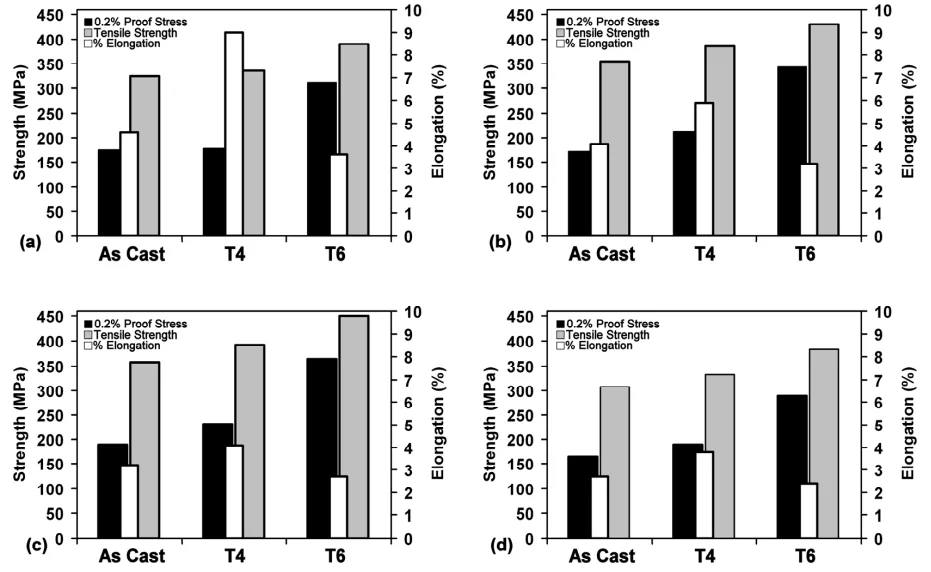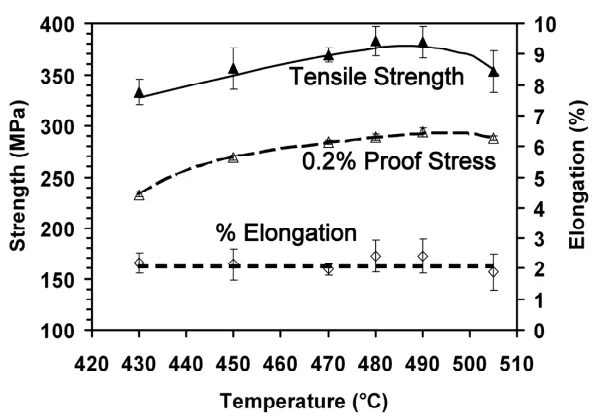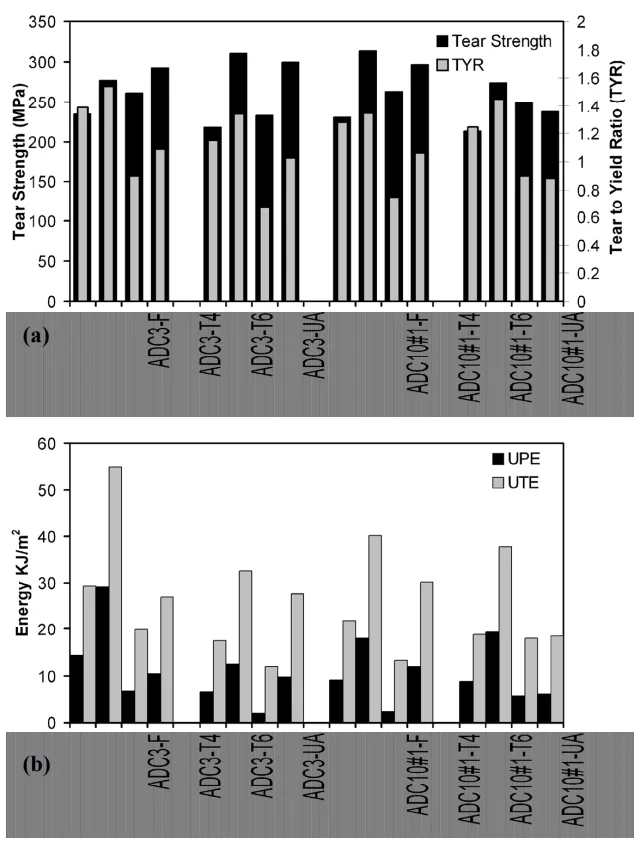This technical summary is based on the academic paper "The Effect of Heat Treatment on Tensile, Fatigue and Fracture Resistance of ADC3, ADC10, and ADC12 Alloys" published by Roger N. Lumley, David Viano, John R. Griffiths, and Cameron J. Davidson in the Proceedings of the 12th International Conference on Aluminium Alloys (2010). It was analyzed and summarized for HPDC experts by CASTMAN experts with the help of LLM AI such as Gemini, ChatGPT, and Grok.

Keywords
- Primary Keyword: Heat treatment of HPDC aluminum alloys
- Secondary Keywords: ADC12 mechanical properties, T6 temper HPDC, Fatigue resistance aluminum alloys, Fracture resistance die casting, ADC10 tensile strength, Solution heat treatment blistering, ADC3 properties
Executive Summary
- The Challenge: Historically, solution heat treatment of High-Pressure Die Casting (HPDC) components was avoided due to high-temperature blistering and dimensional instability, which capped their mechanical performance.
- The Method: Researchers applied a novel, truncated solution heat treatment to common HPDC alloys (ADC3, ADC10, and ADC12) and evaluated their tensile, fatigue, and fracture properties in as-cast, T4, and T6 tempers.
- The Key Breakthrough: T6 heat treatment can increase 0.2% proof stress by 75-100% and dramatically improve fatigue life. The T4 temper significantly enhances fracture resistance, making these HPDC alloys competitive with, and in some cases superior to, permanent mold cast A356-T6.
- The Bottom Line: This validated process unlocks new levels of performance for HPDC components, allowing engineers to design stronger, more durable, and more fracture-resistant parts without the traditional risks of heat treatment.
The Challenge: Why This Research Matters for HPDC Professionals
For decades, engineers have accepted a performance ceiling for conventional aluminum HPDC parts. The very idea of solution heat treatment—a standard process for strengthening other aluminum product forms—was off-limits. The high temperatures required would cause dissolved gases to expand, leading to catastrophic surface blistering and dimensional instability. This has meant that the full potential of widely-used alloys like ADC3, ADC10, and ADC12 remained untapped.
However, as this paper details, the development of a novel heat treatment procedure, which involves a "severe truncation of the solution treatment stage," changes the game entirely. By using shorter times and lower temperatures, the historical problems of blistering can be avoided. This opens the door to significant improvements in tensile strength, fatigue life, and fracture resistance, allowing HPDC to compete in applications once thought impossible.
The Approach: Unpacking the Methodology
To validate this new process, the researchers conducted a rigorous experimental program.
- Casting: HPDC specimens of ADC3, ADC10, and ADC12 alloys were produced on a Toshiba 250-tonne horizontal cold chamber die-casting machine.
- Heat Treatment: A modified procedure was used, with solution treatment times restricted to just 10-15 minutes at temperatures of 505°C for ADC3 and 480°C for ADC10 and ADC12. Parts were then aged to T4 (room temperature ageing), T6 (elevated temperature artificial ageing), and underaged T6 (UA) tempers.
- Testing: The mechanical properties were comprehensively evaluated through:
- Tensile Testing: Cylindrical and flat samples were tested per AS1391.
- Fracture Testing: Tear tests were conducted on machined plates according to ASTM B871.
- Fatigue Testing: Axial pull-pull fatigue tests were performed on cylindrical specimens at a stress ratio of R=0.1.
This combination of controlled casting, innovative heat treatment, and standardized testing provides a robust foundation for the study's groundbreaking conclusions.
The Breakthrough: Key Findings & Data
The results demonstrate a dramatic transformation in the properties of these common HPDC alloys, moving them far beyond their as-cast capabilities.
- Finding 1: T6 Temper Delivers Massive Strength Gains: For all four alloy variations tested, applying a T6 temper resulted in a significant increase in 0.2% proof stress and tensile strength. As shown in Figure 1, the increase in proof stress ranged from 75% for ADC12 to 100% for ADC10#2 compared to the as-cast condition. This comes with only a minor decrease in elongation.
- Finding 2: T4 Temper Boosts Ductility and Toughness: When aged to a T4 temper, the alloys showed a different but equally valuable improvement. For ADC3, elongation nearly doubled from 4.6% to 9% with little change in strength (Figure 1a). For ADC10 and ADC12 alloys, the T4 temper increased 0.2% proof stress, tensile strength, and elongation simultaneously.
- Finding 3: Fracture Resistance Can Surpass Permanent Mold Castings: The tear testing results, shown in Figure 3, reveal that T4 and underaged (UA) tempers produce the best fracture properties. Critically, the study notes that the fracture properties (tear strength, UPE, UTE) determined for HPDC alloys in T4 or UA tempers were "equivalent to or better than those reported for a typical permanent mold cast A356-T6 alloy."
- Finding 4: Excellent Fatigue Performance in T6 Condition: The fatigue life of T6-treated HPDC is excellent. The endurance limit at 10⁷ cycles was greater than 250 MPa for all alloys in the T6 temper. For ADC3 and ADC12 alloys, this limit was even higher, approaching 270 MPa (Figure 4, Table 4). This confirms that strength gains from heat treatment directly translate to superior fatigue resistance.
Practical Implications for HPDC Products
This research isn't just academic; it provides a practical roadmap for enhancing component performance in real-world manufacturing.
- For Process Engineers: The findings validate that a truncated solution heat treatment is a viable, low-risk production method to create high-performance parts. The data in Figure 2 shows that tensile properties for ADC12 are maximized at a solution treatment temperature of 480-490°C, providing a clear processing window that avoids the blistering seen at higher temperatures.
- For Quality Control: The distinct properties of T4 and T6 tempers allow for precise material specification. If a component's critical-to-quality (CTQ) characteristic is maximum strength and fatigue life, a T6 temper is the clear choice. If the CTQ is fracture toughness and damage tolerance, a T4 temper is superior. The data in Table 3 provides the expected tensile property ranges that can be used to set QC limits.
- For Die & Product Design: These results empower designers to confidently specify HPDC for more demanding applications.
- Components requiring high fatigue strength (e.g., engine brackets, chassis components) can be designed with T6-tempered ADC alloys, leveraging fatigue limits up to 270 MPa.
- Parts where energy absorption is critical (e.g., safety-related components) can be designed using the superior fracture toughness of the T4 temper, which outperforms even permanent mold A356-T6.
Paper Details
The Effect of Heat Treatment on Tensile, Fatigue and Fracture Resistance of ADC3, ADC10, and ADC12 Alloys
1. Overview:
- Title: The Effect of Heat Treatment on Tensile, Fatigue and Fracture Resistance of ADC3, ADC10, and ADC12 Alloys
- Author: Roger N. Lumley, David Viano, John R. Griffiths, Cameron J. Davidson
- Year of publication: 2010
- Journal/academic society of publication: Proceedings of the 12th International Conference on Aluminium Alloys, ©2010 The Japan Institute of Light Metals
- Keywords: High Pressure Diecasting, Heat Treatment, Fatigue, Fracture.
2. Abstract:
Until recently, the solution heat treatment of conventional aluminum high pressure die cast (HPDC) parts has not been considered possible because the high temperatures involved cause surface blistering and dimensional instability. Following the development of a novel heat treatment procedure, these problems can now be avoided. As a consequence, the tensile properties of HPDC's can be much improved with little adverse effect on ductility. This paper extends the earlier work to report the effects of these new heat treatment procedures on the tensile, fatigue properties and fracture resistance of HPDC alloys ADC3, ADC10, and ADC12. Comparisons are made between as-cast, T4 and T6 conditions. It is shown that, as with wrought products, the fatigue lives of the alloys are related to their tensile strengths and, as a result, the fatigue resistance of the heat treated aluminum HPDCs is excellent. Fracture resistance, as determined by tear testing, is shown to be optimized in underaged or T4 tempers such that the fracture properties of heat treated HPDC's compare favorably with permanent mold cast 356-T6 (AC4C-T6) alloy.
3. Introduction:
The paper introduces common heat-treatable HPDC alloys (ADC3, ADC10, ADC12) and the historical challenge of applying solution heat treatment due to blistering and distortion. It references recent work [1, 2] that established a new heat treatment procedure involving a severely truncated solution treatment stage (shorter times, lower temperatures). This modified process allows for the partial dissolution of solute elements like Cu and Mg, enabling subsequent age hardening. The paper aims to summarize the outcomes of applying this novel procedure and its effect on the tensile, fatigue, and fracture resistance of these alloys.
4. Summary of the study:
Background of the research topic:
Standard solution heat treatment is not viable for conventional HPDC parts due to blistering. This has limited their mechanical properties.
Status of previous research:
Previous studies [1-4] by the authors and others developed a modified, short-duration solution heat treatment that avoids blistering and significantly improves tensile properties. T7 tempers have also been investigated for elevated temperature applications.
Purpose of the study:
This paper extends the earlier work to provide a comprehensive report on the effects of the new heat treatment procedures (T4 and T6 tempers) on not just tensile properties, but also the fatigue and fracture resistance of ADC3, ADC10, and ADC12 alloys.
Core study:
The core of the study involves casting test specimens of four different alloy compositions (one ADC3, two ADC10 with different Mg content, and one ADC12), subjecting them to as-cast, T4, and T6 conditions, and performing detailed mechanical testing to quantify the changes in tensile strength, elongation, fracture energy, and fatigue life.
5. Research Methodology
Research Design:
The study was designed to compare the mechanical properties of three HPDC alloys in as-cast, T4, and T6 conditions. An underaged (UA) T6 temper was also included for fracture testing.
Data Collection and Analysis Methods:
- Casting: Specimens were produced using a 250-tonne Toshiba horizontal cold chamber die-casting machine.
- Tensile Samples: Cylindrical and machined-from-plate samples were prepared and tested according to AS1391.
- Tear Test Samples: Samples were machined from 2mm thick plates and tested per ASTM B871 to measure fracture resistance.
- Fatigue Samples: Cylindrical specimens were tested under axial pull-pull loading at 60Hz with a stress ratio R=0.1.
- Heat Treatment: Solution treatment was 15 minutes for tensile/fatigue samples and 10 minutes for tear plates at 505°C (ADC3) or 480°C (ADC10/ADC12). T4 ageing was 14 days at 25°C. T6 ageing was 2.5h at 180°C (ADC3) or 24h at 150°C (other alloys).
Research Topics and Scope:
The research covers three widely used JIS specification alloys: ADC3, ADC10, and ADC12. The scope is focused on quantifying the improvement in three key mechanical properties: tensile response, fracture resistance, and fatigue resistance after applying a novel heat treatment.
6. Key Results:
Key Results:
- Heat treating to a T6 temper significantly increases 0.2% proof stress (by 75-100%) and tensile strength for all alloys, with only a small decrease in elongation versus as-cast.
- Heat treating to a T4 temper offers an excellent combination of properties, particularly for ADC3 where elongation nearly doubled to 9%.
- Fracture resistance is substantially improved in the T4 temper, with properties shown to be equivalent to or better than those reported for permanent mold cast A356-T6 alloy.
- The fatigue properties of heat-treated HPDCs are excellent. The fatigue endurance limit for T6-treated alloys is >250 MPa, with ADC3 and ADC12 reaching ~270 MPa.
- The tensile properties achieved are strongly dependent on solution treatment temperature, with 480-490°C being optimal for ADC12 to maximize strength without inducing blistering.
Figure Name List:



- Fig. 1. Tensile properties of the four alloys made from cylindrical tensile test bars examined in as-cast, T4 and T6 tempers. (a), ADC3, (b), ADC10#1, (c) ADC10#2, (d) ADC12.
- Fig. 2. Tensile properties of the ADC12 alloy studied as a function of solution treatment temperature.
- Fig. 3. a) shows tear strength and tear-to-yield ratio for the four alloys; b) shows the unit propagation energy, (UPE) and unit total energy (UTE).
- Fig. 4. Axial S-Nf data, R = 0.1. in as-cast and T6 conditions (a) shows ADC3, (b) shows ADC10 and (c) shows ADC12. Data at 10⁷ cycles are runouts.
7. Conclusion:
- Conventionally produced high pressure diecastings based around the compositions for ADC3, ADC10 and ADC12 may be successfully heat treated to develop high mechanical properties.
- By heat treating to a T4 temper, values of 0.2% proof stress, tensile strength and elongation may be increased simultaneously. In the alloy ADC3 aged to a T4 temper, there was little change to the 0.2% proof stress or tensile strength, but the elongation was nearly doubled from 4.6 to 9%.
- In a T6 temper, tensile properties may be increased as much as 75-100% for 0.2% proof stress values, with only a small decrease in elongation compared to the as-cast condition.
- The fracture properties of heat treated high pressure diecastings may be significantly improved by the use of T4 or underaged T6 tempers. In particular, underaged T6 tempers offer excellent combinations of tensile and fracture properties in most alloys, for only a small sacrifice in strength compared to the fully hardened T6 condition.
- Fatigue properties of heat treated HPDC's are excellent. For ADC3 or ADC12 alloys, the fatigue limit may be as high as 270 MPa. In both the as-cast and T6 tempers, these alloys show higher ratios of fatigue endurance limit to tensile strength and in T6 tempers, display higher absolute fatigue properties.
8. References:
- [1] R.N. Lumley, R.G. O'Donnell, D.R. Gunasegaram, M. Givord: International Patent Application PCT/2005/001909, WO2006/066314.
- [2] R.N. Lumley, R.G. O'Donnell, D.R. Gunasegaram, M. Givord: Met. & Mat. Trans. A, 2007, 38A, 2564-2574.
- [3] R.N. Lumley, I.J. Polmear and P.R. Curtis: Met. & Mat. Trans. A, Vol.40, #7, p.1716-1726 (2009).
- [4] R.N. Lumley, M. Gershenzon, D.R. Gunasegaram, C.J. Davidson, A.C. Yob: Conf. Proc. 113th Metalcasting Congress, NADCA, 2009, paper T09-042.
- [5] J.G. Kaufman: "Fracture Resistance of Aluminum Alloys", The Aluminum Association, ASM International, Ohio, (2001), p.37-74.
Expert Q&A: Your Top Questions Answered
Q1: What's the single biggest advantage of using a T6 heat treatment for my HPDC components?
A1: The biggest advantage is a massive increase in strength and fatigue resistance. According to the paper's conclusion, a T6 temper can increase the 0.2% proof stress by 75-100% over the as-cast condition. Furthermore, the fatigue endurance limit for T6-treated ADC3 and ADC12 alloys can be as high as 270 MPa, making them suitable for high-stress, cyclic loading applications (Conclusion 5, Figure 4).
Q2: My application requires high toughness and energy absorption, not maximum strength. Which temper should I specify?
A2: For toughness and fracture resistance, you should specify a T4 or an underaged (UA) T6 temper. The research shows that in these conditions, the fracture properties are significantly improved and can be "equivalent to or better than" those of a permanent mold cast A356-T6 alloy, which is a benchmark for good fracture properties (Conclusion 4, Figure 3).
Q3: How exactly does this process avoid the classic blistering problem that plagues HPDC heat treatment?
A3: This process avoids blistering by using a "severe truncation of the solution treatment stage" (Introduction). This means using significantly shorter exposure times (10-15 minutes) and carefully controlled, lower temperatures (e.g., 480-490°C) than a traditional solution treatment. This protocol dissolves enough alloying elements to enable age hardening without giving trapped gases the time or thermal energy to cause blistering.
Q4: Does this new heat treatment work for all aluminum die-casting alloys?
A4: This study focused specifically on ADC3, ADC10, and ADC12 alloys, which are some of the most common alloys used in the industry (Table 1). The successful and significant improvements across all three suggest the principles are broadly applicable to other heat-treatable HPDC aluminum alloys, but specific parameters would need to be optimized for each one.
Q5: How significant is the fatigue life improvement compared to the as-cast condition?
A5: The improvement is very significant. As seen in the S-N curves in Figure 4, the T6 condition vastly outperforms the as-cast condition at all stress levels. For ADC3, the as-cast endurance limit is around 205 MPa, while the T6 limit is 270 MPa—a 32% increase. This data provides engineers with the confidence to use heat-treated HPDC parts in applications where fatigue is a primary design concern (Table 4).
Conclusion & Next Steps
This research provides a valuable roadmap for enhancing the mechanical properties of HPDC components. The findings offer a clear, data-driven path toward improving part strength, durability, and fracture resistance, effectively breaking through the traditional performance limitations of the die-casting process.
At CASTMAN, we are dedicated to applying the latest industry research to solve our customers' most challenging die casting problems. If the issues discussed in this paper resonate with your operational goals, contact our engineering team to discuss how we can help you implement these advanced principles in your components.
Copyright
- This material is a paper by "Roger N. Lumley, David Viano, John R. Griffiths, Cameron J. Davidson". Based on "The Effect of Heat Treatment on Tensile, Fatigue and Fracture Resistance of ADC3, ADC10, and ADC12 Alloys".
- Source of the paper: The paper was published in the "Proceedings of the 12th International Conference on Aluminium Alloys, September 5-9, 2010, Yokohama, Japan." A direct DOI URL is not available in the provided document.
This material is for informational purposes only. Unauthorized commercial use is prohibited. Copyright © 2025 CASTMAN. All rights reserved.